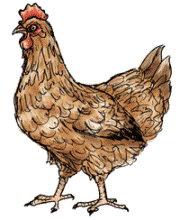If you keep poultry it is very important to learn how to detect an unhealthy or sick bird, so that you can take action. If you do not, disease may spread to other birds and the whole flock may be lost.
Diseases may be introduced into the flock by:
- Buying birds from unreliable sources.
- Allowing adult birds, which may be disease carriers, to mix with chicks.
- Allowing birds which are disease carriers from other poultry farms to mix with your healthy chickens.
- Rodents, flies and wild birds which may be disease carriers mixing with healthy chickens.
- Giving dirty water or feeding contaminated or stale food to chickens.
- People who may carry diseases on their feet, hands or clothes.
- Using old litter which may contain diseases or not cleaning or disinfecting the poultry houses.
- Contaminated equipment (feed and water troughs).
Diseases will be very serious in chickens that are not well fed and given clean water at all times. They should be kept in hen houses which have enough fresh air and, whenever possible, be vaccinated against preventable diseases.
As well as keeping their birds healthy, farmers can control diseases on their farms by not mixing chicks with older birds when brooding and buying chicks from reliable sources only.
Healthy bird

- Alert and on guard
- Bright eyes and comb
- Walks, runs, stands, and scratches
- Eats and drinks normally
- Smooth and neat feathers
- Soft compact droppings
- Breathes quietly
Unhealthy or sick bird

- Tired and lifeless
- Dull eyes and comb
- Sits or lies down
- Lays less or stops laying
- Ruffled and loose feathers
- Wet droppings with blood or worms
- Diarrhoea
- Coughs, sneezes and breathes noisily
Common diseases in chickens
Newcastle disease
Newcastle disease is an acute, deadly disease that affects chickens of all ages, as well as some other types of poultry. It is caused by a virus that can remain alive in manure for up to 2 months and in dead carcasses for up to 12 months, however it is easily killed by disinfectants, fumigants and direct sunlight. It spreads rapidly, and may kill most of the chickens in the area. The nervous and respiratory (breathing) systems are usually affected.
Symptoms
- Fever, depression and loss of appetite
- Swollen head, and sometimes swollen wattles
- Watery discharge from nostrils and eyes, with difficult breathing
- Nervous signs such as twisting of the head and neck, paralysis and walking as if drunk, wings relaxed and held away from body
- Green diarrhoea which is sometimes bloody
- Sudden death
Diagnosis
- Post-mortem by trained animal health worker (signs include red swelling in the wall of the oesophagus and digestive system, yellow spots in intestines)
- No history of Newcastle disease vaccination
Treatment
There is no treatment. You need to kill and dispose of all sick birds (see page 14).
Prevention
Vaccination. Maintaining good hygiene and disposing properly of sick chickens.
Fowl pox
Fowl pox is a disease of chickens that spreads gradually by mosquitoes. It is caused by a virus and affects chickens of all ages as well as many other bird species. It is seen in two forms: the dry form which causes skin sores (scabs), and the wet form which causes sores in the mouth and throat. The wet form may cause choking if the windpipe gets blocked.
Symptoms
- Sores on the parts of the body without feathers (head, eyes, legs, vent) that may later form scabs and ooze pus
- Sores on the tongue, in the mouth and trachea, that may cause death from choking
- Eyelids may be stuck together so that the affected chickens cannot see to eat or drink
- Feet and legs may be affected and swollen
Diagnosis
Post-mortem will find sores, especially scabs, on face, mouth, throat or feet
Treatment
- Separate all affected chickens from the flock
- Give affected chickens special care by:
- providing easy access to food and water
- cleaning sores and applying antibiotic ointment or Gentian Violet
- applying antibiotic ointment made specifically for eyes. Warning: Never put ordinary skin ointment in or near the eyes.
Prevention
- Vitamins or antibiotics in the drinking water are helpful
- Vaccination
- Reduce mosquitoes around the poultry house by draining areas where mosquitoes breed. During an outbreak, it may be necessary to use mosquito spray inside and around the poultry house.
Chronic Respiratory Disease (CRD)
Chronic respiratory disease is a disease caused by an organism called ‘Mycoplasma gallisepticum’. It is initially introduced to flocks by infected eggs but then spreads by bird-to-bird contact and by contact with droplets that are breathed out by the chickens into the air or onto equipment. Moving, overcrowding or stressing chickens in any way may trigger an outbreak of CRD. The disease is complex because three or more conditions are needed for the disease to develop. One condition is the presence of mycoplasma organisms. The second condition is stress (eg extreme temperatures and humidity, being transported or the addition of new birds into an established flock). The third condition is presence of another bacteria, such as E. coli. CRD also affects turkeys, game birds, pigeons and other wild birds. Ducks and geese can become infected when held with infected chickens.
Symptoms
- Discharge from the eyes or nostrils
- Difficult breathing
- Lack of appetite for feed and water
- Failure to grow properly
Diagnosis
Post-mortem will find a thick, yellow pus (cheese-like) around the heart, in the lungs and air sacs; the trachea or windpipe is inflamed (red in colour) and sinuses are inflamed (reddened in colour) and contain mucus.
Treatment
Antibiotics (always consult an animal health worker before treating your chickens).
Prevention
- For broilers: raise only one age group at a time (called an ‘all-in, all-out’ programme). Clean and disinfect between each group of broilers.
- Buy chicks from good hatcheries that are guaranteed to have no mycoplasma. Chicks from these hatcheries may cost more.
- Ask an animal health worker for advice on doing a blood test for mycoplasma. Hatching eggs only from hens which test negative will prevent the disease spreading.
External parasites
Lice, mites, ticks and fleas are common external parasites of chickens. Lice and mites bite and damage the skin. Mites, ticks and fleas suck the blood and cause anaemia (thin blood) and poor egg production. Certain external parasites can carry other diseases, such as fowl pox.
Symptoms
- Lice cause scaly, damaged skin and are often visible to the human eye.
- Scaly-leg mites cause crusty, thickened, unsightly legs. Red mites (also called nocturnal mites) attack during the night and can cause severe anaemia, which makes the birds weak and poor egg producers. Feather mites produce scabs and also lead to anaemia resulting in poor egg production. Feather mites tend to look like moving dust particles.
- Fleas can burrow into the skin and cause ulcers.
- Mosquitoes can suck the blood of birds and cause poor egg production, or even death. Mosquitoes also carry several viral diseases such as Fowl pox.
- Ticks attack at night and suck blood resulting in anaemia and poor egg production. Often red spots can be seen where the ticks have fed. Ticks can also carry diseases.
Treatment
Consult an animal health worker who will be able to prescribe insecticides to kill the parasite. For leg mites, the legs can be dipped in kerosene. However, great care must be taken not to let the kerosene touch the feathers or skin. Warning: Insecticides can be poisonous if used improperly. Always mix and apply according to the instructions.
This article has been adapted from ‘Where there is no animal doctor’ by Dr Peter Quesenberry and Dr Maureen Birmingham, Christian Veterinary Mission, ISBN 1-886532-11-7. Visit www.cvmusa.org/books to order a hard copy.









